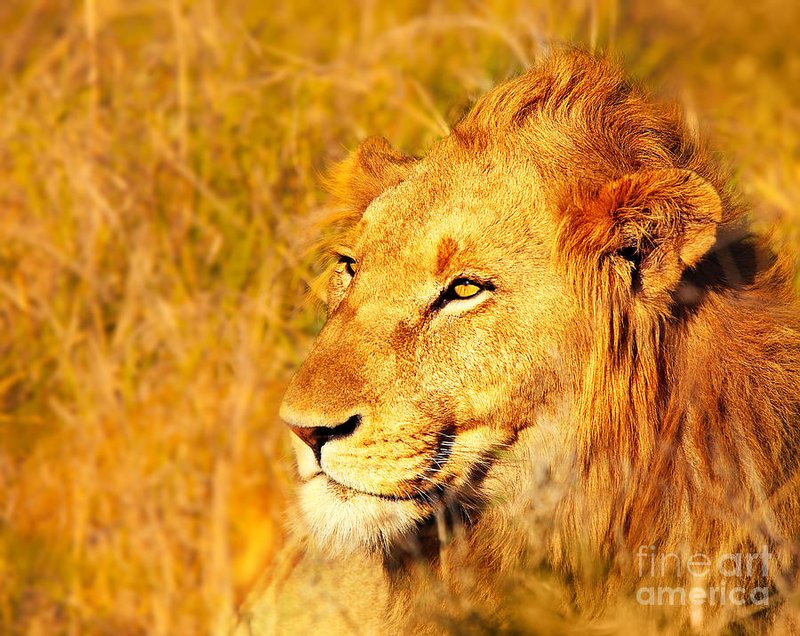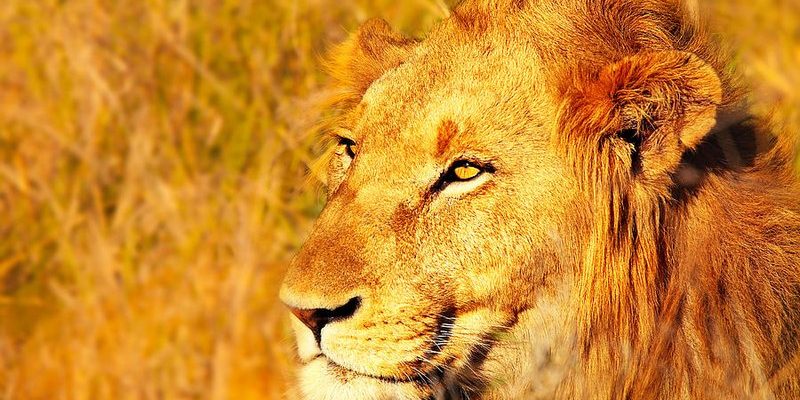
The African lion is one of the most iconic animals in the world, and it certainly lives up to its reputation. Often referred to as the “king of the jungle,” this magnificent creature roams the savannas and grasslands of Africa. But here’s the thing: lions don’t actually live in jungles! They thrive in open spaces where they can hunt and roam free. Their powerful roars can travel for miles, serving as a reminder of their dominance in the animal kingdom.
You might be wondering what makes the African lion so special. Beyond their impressive manes and commanding presence, these lions are fascinating creatures with complex social structures and behaviors. They live in prides, primarily consisting of related females and their offspring, while a few males guard the territory. Join me as we look deeper into the lives of these majestic animals, their habitat, diet, and conservation efforts!
Physical Characteristics
African lions are among the largest of the big cats, and their physical features are truly remarkable. Adult male lions typically weigh between 330 to 550 pounds (150 to 250 kg), while females usually weigh from 265 to 400 pounds (120 to 180 kg). Males are easily recognized by their stunning manes, which can vary in color from tawny to dark brown, providing them with a majestic appearance. The mane also serves a practical purpose, as it offers protection during fights with rival males.
Another striking characteristic is their powerful bodies. Lions have strong, muscular legs built for short bursts of speed, reaching up to 50 miles per hour (80 km/h) in a sprint. Their claws are retractable, allowing them to keep them sharp for hunting. Their keen eyesight is adapted for both day and night, giving them an advantage when stalking prey. The combination of strength, speed, and stealth makes the African lion an apex predator.
A unique and often overlooked feature of lions is their social structure. Unlike other big cats that prefer solitary lives, lions form close-knit groups called prides. This social behavior greatly influences their physical characteristics as well, with male lions developing larger bodies and more impressive manes due to competition for mates and dominance within their group.
Habitat and Distribution
The African lion is primarily found in sub-Saharan Africa, inhabiting a range of environments from grassy plains to semi-arid desert regions. Their habitat is crucial for their survival as it provides ample prey and space to roam. Historically, these lions had a broader range, extending into Europe and Asia, but habitat loss and hunting have severely reduced their populations in many areas.
Today, the African lion’s populations are concentrated in protected areas like national parks and wildlife reserves, where conservation efforts are focused. Iconic locations such as the Serengeti in Tanzania and Kruger National Park in South Africa provide ideal habitats for these magnificent beasts. Unfortunately, outside these protected areas, lions face significant threats due to habitat encroachment and human-wildlife conflict.
Preserving their habitat is essential not just for lions but also for the balance of the ecosystem. With their predator status, lions help control herbivore populations, ensuring no single species dominates the landscape. Maintaining healthy habitats supports a diverse range of flora and fauna, making it vital for both lions and the broader environment.
Diet and Hunting Behavior
African lions are carnivorous hunters, and their diet primarily includes large ungulates like zebras, wildebeests, and buffalo. They are social hunters, often working together in groups to hunt and take down larger prey. This cooperative behavior increases their chances of a successful hunt, which is vital for the survival of the pride.
Lions use a variety of strategies to hunt, depending on their environment and the type of prey. For instance, they might stalk their prey quietly and use a sudden burst of speed to close the gap. Once they’re close enough, a well-placed pounce can make the difference between a meal and a missed opportunity. Interestingly, female lions do most of the hunting for the pride, while males typically feed first due to their dominant status.
The social dynamics within the pride play a key role in hunting success. A pride’s structure allows for coordinated attacks and effective teamwork, making every hunt a strategic operation. After they’ve caught their prey, lions feast together, with the dominant males eating first, followed by the females and cubs. Sharing a meal strengthens bonds within the pride and ensures all members are nourished.
Social Structure and Behavior
The social life of the African lion is fascinating and differs significantly from other big cats. Lions live in prides that can range from a few individuals to over 30 members. This social structure usually consists of a group of related females, their cubs, and a few adult males. While females collaborate in hunting and raising young, males primarily focus on protecting their territory and ensuring the safety of the pride.
Within the pride, a hierarchy exists. The dominant male, or coalition of males, has the first choice of food and mates. However, these males face challenges from rival lions seeking to take over their pride. When a new male takes control, it’s not uncommon for him to kill existing cubs to ensure that the new females are ready to mate and bear his offspring. This behavior might seem cruel, but it’s a part of the natural order in the wild.
African lions also communicate through a range of vocalizations, from roars to growls and even purring. Their famous roars can be heard from up to 5 miles away and serve various purposes, like marking territory and communicating with pride members. These vocalizations show just how social and communicative lions truly are!
Conservation Status
The African lion faces several threats that have resulted in a dramatic decline in their populations. Habitat loss due to human encroachment, poaching, and conflicts with livestock are significant factors contributing to their endangered status. According to the International Union for Conservation of Nature (IUCN), lions are currently classified as vulnerable, with their numbers dwindling in the wild.
Conservation efforts are crucial for protecting these majestic animals. Many organizations work tirelessly to create protected areas and develop community-based conservation programs. These initiatives not only aim to preserve lion populations but also to mitigate human-wildlife conflict, ensuring that local communities understand the value of coexisting with wildlife.
In addition to habitat protection, awareness campaigns play a vital role in lion conservation. Educating the public about the ecological importance of lions can help garner support for their protection. The more we understand and appreciate these amazing creatures, the more likely we are to take action to ensure their survival for future generations. Remember, every little bit helps when it comes to saving the African lion!
Interesting Facts
| Scientific Name: | Panthera leo |
| Weight: | Males: 330-550 lbs, Females: 265-400 lbs |
| Length: | 8-10 feet from head to tail |
| Habitat: | Savannas, grasslands, and open woodlands |
| Diet: | Carnivorous; primarily large ungulates |
| Speed: | Up to 50 mph (80 km/h) in short bursts |
| Lifespan: | 10-14 years in the wild; up to 20 years in captivity |
The African lion is not just a fierce predator; it’s a symbol of strength and majesty in the animal kingdom. Understanding their lives helps us appreciate the delicate balance of nature and the importance of conservation efforts. From their fascinating social structures to their hunting techniques, lions captivate us with their behavior and presence. As they continue to face challenges, it’s up to us to ensure that these magnificent creatures thrive in their natural habitats.
FAQ
What is the primary threat to African lions?
One of the biggest threats to African lions is habitat loss due to human expansion. As communities grow and farmland expands, lions lose their natural habitats. Additionally, poaching and human-wildlife conflict, especially with livestock, further threaten their populations. Conservation efforts aim to mitigate these impacts and secure safe spaces for lions to roam.
How do African lions communicate?
African lions are very vocal animals, using a variety of sounds to communicate. This includes roars, growls, and even purrs. Their roars can be heard from great distances, as they serve to establish territory and communicate their presence to both pride members and rivals. Vocalizations play a crucial role in maintaining the pride’s social structure and cohesion.
Do male lions have a role in raising cubs?
While male lions are primarily responsible for protecting the pride and territory, they do play a role in the upbringing of cubs. Males may help defend the pride against intruders, allowing females the security to nurture their young. However, the females are the primary caregivers and do most of the raising and teaching of the cubs.
How fast can an African lion run?
An African lion can reach speeds of up to 50 miles per hour (80 km/h) in short bursts. However, they are not built for endurance running, so they typically rely on their strength and teamwork to catch prey rather than sustained speed. Their hunting strategies often depend on stealth and surprise rather than sheer speed.
What do lions eat in the wild?
African lions primarily eat large ungulates such as zebras, wildebeests, and buffalo. Their hunting is typically done in groups, allowing them to tackle larger prey more effectively. This social hunting dynamic enhances their chances of success and helps keep the pride well-fed.
What is the lifespan of an African lion?
In the wild, African lions generally live between 10 to 14 years. However, when in captivity, their lifespan can extend to around 20 years due to better healthcare and absence of threats from other animals or humans. Their lifespan can vary based on factors such as environmental conditions and human impact.
How do lions establish their territory?
Lions establish their territory through vocalizations, marking their area with scent, and displaying aggressive behavior if challenged by other lions. They use their roars to declare their presence and warn intruders. Territorial disputes can lead to fights, especially between males defending their pride.
How many cubs can a lioness have at once?
Typically, a lioness can give birth to a litter of 1 to 4 cubs, although larger litters are not uncommon. The cubs are born blind and rely heavily on their mothers for protection and nourishment. Lionesses will often synchronize their births, which can increase the survival rate of the cubs, as they provide mutual support during the early months.
Are African lions endangered?
Yes, African lions are categorized as vulnerable due to declining populations. Factors such as habitat loss, poaching, and human-wildlife conflict contribute to their endangered status. Conservation efforts are crucial for protecting their habitats and ensuring their survival, so that future generations can enjoy the presence of these remarkable animals.
What conservation efforts are in place for African lions?
Numerous conservation efforts are aimed at protecting African lions. These include creating and maintaining protected areas, community-based conservation programs that promote coexistence between humans and wildlife, and fundraising campaigns to support lion conservation. Public awareness and education are also essential in garnering support for lion protection, ensuring that their populations can be sustained.
Can African lions swim?
While African lions are not known for their swimming abilities, they can swim when necessary. However, they generally prefer to stay on land. They may enter water to cool off or cross rivers but are more comfortable on dry ground. Their strong bodies are built for running and hunting rather than swimming.

